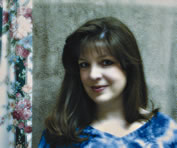When
I was a girl, I loved all things wild. I loved roaming the forest
behind our house and the meadows that surrounded our farm. And when I was a girl, my mother taught me to love wolves. In the late
60s and early 70s, new scientific ground was being broken by the idea
that predators brought balance and health to wilderness. I remember her
reading aloud passages from books that spoke of the direct genetic
connection between Canis lupus and my beloved St. Bernard. She read
that wolves spoke using not just sound, but body position, ear and tail
carriage a language as subtle and fine as eye contact from one animal
to another.
And when I was a girl, my mother taught me to love wolves. In the late
60s and early 70s, new scientific ground was being broken by the idea
that predators brought balance and health to wilderness. I remember her
reading aloud passages from books that spoke of the direct genetic
connection between Canis lupus and my beloved St. Bernard. She read
that wolves spoke using not just sound, but body position, ear and tail
carriage a language as subtle and fine as eye contact from one animal
to another.
This culture of the wolf, the complex language and family relationships so reminiscent of human families, lit a flame in me. This was natural in a girl that followed the game trails of deer through the thick forest floor tangle of mountain laurel and wild azalea. It was not natural, however, for the daughter of a rancher, a dairy farmer, the daughter of a realistic man who believed that animals were placed here to serve man and therefore under his dominion as decreed by God. The idea of wolves took root deep in my young chest and a world without the keen eye and fine minds of predators seemed unimaginable and surely undesirable.
There were whispers of bringing wolves back to Yellowstone, and it became my private dream to see that happen. I sent letters to senators and congressmen, and even to the president, asking politely for the return of wolves, which we punished and destroyed with something akin to religious zeal. We chose unusually cruel means of ridding ourselves of these predators, setting their dens and pups on fire; wiring their jaws shut and leaving them to starve; literally tearing them limb from limb.
Humans often attribute to wolves characteristics more symbolic than biological we make them representative of either savior or demon. They are neither; they are merely animals.
I got my wish in March 1995, when gray wolves were reintroduced to Yellowstone and the wild places in Idaho. Since then, I have been in the presence of wild wolves many times. I have heard their song carried on the sage-scented air. I’ve watched them interact in societies and families in ways similar to human interactions. I’ve watched them greet family members that have been gone; seen them play, in complete abandon, with their pups; noticed the elk, that are their prey, become sharper and more alert. I once watched a young wolf cross my scent trail, respond to my presence, and finally meet my eyes with her own gold gaze.
I must tell you there is nothing else like it on Earth. There is a value in the existence of something so unspoiled and natural that I cannot describe to you. You must experience it for yourself to know what I mean.
There is an exhilarating tonic to being in the presence of the real wild. It allows me to carry on with my domesticated life, in a place where one can only imagine the luxury of being alone. I like the idea that somewhere wolves are slipping through the forest, doing what it is that wolves do, while I am at my desk. There is value in that even for people who don’t realize that a touch of wild is what theyre looking for when they feel restless and unsatisfied with their tame lives.
Why wolves in Colorado? Because the elk have forgotten them and, undisciplined, eat everything in their path. Disease feeds on them, threatening their viability. Because we could do far worse than imagining the comings and goings of wolves, the throb of their howling, the bonds of their community. We need wolves in Colorado because we are losing our own wild nature, becoming domesticated and fat and lazy. What made us beautifully unique among the 50 states becomes less true with each passing day. And because there is ample room for them, in the hundreds and hundreds of acres of wildlands in our state, and in the vast ground of our imaginations, where lands lie wasting for inspiration.
Why wolves? Because if you never see a wolf slipping like an evening shadow through the trees, if you never hear the wild melody in a chorus of howls or witness the pack teaching pups the grace and skill of the hunt, reminding the elk to be wary and sleek and fast, you can always dream that one day you will. They will be back in their rightful place, returning the land to balance, back where they belong.
Anne Rohrer is a wildlife photographer with a special affinity for the Greater Yellowstone Ecosystem. She lives in Denver.
We don’t have a paywall because, as a nonprofit publication, our mission is to inform, educate and inspire action to protect our living world. Which is why we rely on readers like you for support. If you believe in the work we do, please consider making a tax-deductible year-end donation to our Green Journalism Fund.
DonateGet four issues of the magazine at the discounted rate of $20.